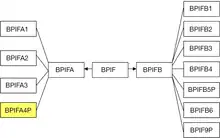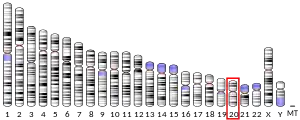BPIFA4P
BPI fold containing family A, member 4 (BPIFA4) is a non-human protein encoded by the Bpifa4 gene in mammals such as monkey, cat, and cow but does not appear in rodents and humans.[3][4] It is also known as Latherin in horse, encoded by the Lath/Bpifa4 gene but is somewhat divergent from the other species.[5][6][7] Latherin/BPIFA4 is a secreted protein found in saliva and sweat.
| BPIFA4P | |||||||||||||||||||||||||||||||||||||||||||||||||||
|---|---|---|---|---|---|---|---|---|---|---|---|---|---|---|---|---|---|---|---|---|---|---|---|---|---|---|---|---|---|---|---|---|---|---|---|---|---|---|---|---|---|---|---|---|---|---|---|---|---|---|---|
| Identifiers | |||||||||||||||||||||||||||||||||||||||||||||||||||
| Aliases | BPIFA4P, BASE, BPI fold containing family A member 4, pseudogene | ||||||||||||||||||||||||||||||||||||||||||||||||||
| External IDs | OMIM: 607627 GeneCards: BPIFA4P | ||||||||||||||||||||||||||||||||||||||||||||||||||
| |||||||||||||||||||||||||||||||||||||||||||||||||||
| |||||||||||||||||||||||||||||||||||||||||||||||||||
| Wikidata | |||||||||||||||||||||||||||||||||||||||||||||||||||
| |||||||||||||||||||||||||||||||||||||||||||||||||||
In humans, no functional protein expressed therefore BPIFB4P is referred to as a pseudogene.[7][8][9] However, a non-functional protein does appear; it known as BASE protein, secreted by breast cancer cell lines and salivary gland tissue (see section below).[10][11]
Superfamily
BPIFA3 is a member of a BPI fold protein superfamily defined by the presence of the bactericidal/permeability-increasing protein fold (BPI fold) which is formed by two similar domains in a "boomerang" shape.[12] This superfamily is also known as the BPI/LBP/PLUNC family or the BPI/LPB/CETP family.[13] The BPI fold creates apolar binding pockets that can interact with hydrophobic and amphipathic molecules, such as the acyl carbon chains of lipopolysaccharide found on Gram-negative bacteria, but members of this family may have many other functions.

Genes for the BPI/LBP/PLUNC superfamily are found in all vertebrate species, including distant homologs in non-vertebrate species such as insects, mollusks, and roundworms.[7][14] Within that broad grouping is the BPIF gene family whose members encode the BPI fold structural motif and are found clustered on a single chromosome, e.g., Chromosome 20 in humans, Chromosome 2 in mouse, Chromosome 3 in rat, Chromosome 17 in pig, Chromosome 13 in cow. The BPIF gene family is split into two groupings, BPIFA and BPIFB. In humans, BIPFA consists of 3 protein encoding genes BPIFA1, BPIFA2, BPIFA3, and 1 pseudogene BPIFA4P; while BPIFB consists of 5 protein encoding genes BPIFB1, BPIFB2, BPIFB3, BPIFB4, BPIFB6 and 2 pseudogenes BPIFB5P, BPIFB9P. What appears as pseudogenes in humans may appear as fully functional genes in other species.
Function
Although BPIFA4P is identified as a pseudogene in humans,[7][9] the RNA sequence for a wikt:putative protein has been detected at moderate levels in several glands (including salivary and mammillary), skin, and breast cancer.[15][11] That pattern is consistent with the expression of normal BPIFA4/Latherin found in saliva and sweat of other species such as cow,[4] horse,[5][6] and sheep.[16] The function of BPIFA4 in those species is associated with BPIFA gene family members' properties of being a surfactant and binding to bacterial lipopolysaccharides. Sweat helps animals cool down, and in animals with pelts/fur BPIFA4/Latherin significantly reduces surface tension of sweat, acting as a wetting agent to facilitate evaporative cooling. Further, it is speculated that the presence of a surfactant protein in the saliva of ruminant animals (e.g., cow, horse, sheep) may assist in mastication of large quantities of vegetable matter in their diet.[6] BPIFA4 in saliva also may function as a first line of defense against bacteria, via bactericidal functions similar to other BIPFA and BIPFB family members.
BASE Protein
The expression of a pseudogene product in humans has caused unresolved issues about BPIFA4 in humans. This uncommon situation was summarized by Bingle and colleagues at University of Sheffield, who did extensive work on the BPI/LBP/PLUNC family:
"Human BPIFA4 appears to be an example of a pseudogene (and should be properly identified as BPIFA4P) that is perhaps better described as a ‘dying’ gene, since it appears to be both transcribed and translated, but no longer encodes a functional protein product."[17]
That non-functional protein came to be known as BASE (Breast cancer And Salivary gland Expression) protein.[11] Using a screening method for identifying human genes that code for membrane proteins, researchers at the National Cancer Institute discovered in 2003 a previously uncharacterized gene in breast cancer cell lines. With RT-PCR and Northern blot techniques, they detected the expression of BASE RNA in several breast cancer cell lines but not normal breast tissue. Separately BASE RNA expression was found in salivary gland tumors and normal salivary gland tissue.[11][18] Thus the acronym was devised to reflect that pattern. Investigators at EMBL subsequently confirmed BASE/BPIFA4P expression in ~50% of actual breast cancer tumor samples they tested.[19] In particular, BASE/BPIFA4P expression was present in tumors with high levels of ERα estrogen receptor but not in tumors with low ERα. However, it was shown experimentally that estrogen represses the expression of the BASE/BPIFA4P gene, while the transcription factor FOXA1 activates the expression of BASE/BPIFA4P. The undetermined interplay between ERα and FOXA1 is likely to be important in hormone receptor-positive disease and acquired anti-hormone resistance.[20] Although the BASE protein's potential function was never investigated, the presence of the BASE/BPIFA4P gene was nevertheless considered a potentially useful marker for breast cancer screening.
The BASE gene deposited into US and European databases was eventually recognized as being a member of the BPI/LBP/PLUNC family and subsequently relabeled as BPIFA4P.[7] It was further recognized that unlike other primate genes for BPIFA4, the human BASE/BPIFA4P gene was missing a single nucleotide in exon 6. That deletion causes a frameshift mutation which results in a "premature" stop codon.[17] The resulting human BASE protein is much shorter than the functional BPIFA4 and Latherin proteins of other species. The original analysis predicted the BASE protein to be 19.5 kDa in size,[9] but Western blots show the protein migrates at a size larger than 22 kDa.[21] This truncated human BASE protein lacks key structural elements of a functional BPIFA4 protein, namely a long α-helical segment that creates the BPI fold. Without that, BASE cannot function like any other BPI/LBP/PLUNC family member and is thus considered functionless.
References
- GRCh38: Ensembl release 89: ENSG00000183566 - Ensembl, May 2017
- "Human PubMed Reference:". National Center for Biotechnology Information, U.S. National Library of Medicine.
- "BPIFA4 BPI fold containing family A, member 4 [Macaca mulatta (Rhesus monkey)] - Gene - NCBI". www.ncbi.nlm.nih.gov. Retrieved 18 February 2023.
- "BPIFA4 BPI fold containing family A, member 4 [Bos taurus (cattle)] - Gene - NCBI". www.ncbi.nlm.nih.gov. Retrieved 18 February 2023.
- "LATH latherin [Equus caballus (horse)] - Gene - NCBI". www.ncbi.nlm.nih.gov. Retrieved 18 February 2023.
- McDonald RE, Fleming RI, Beeley JG, Bovell DL, Lu JR, Zhao X, et al. (May 2009). "Latherin: a surfactant protein of horse sweat and saliva". PLOS ONE. 4 (5): e5726. Bibcode:2009PLoSO...4.5726M. doi:10.1371/journal.pone.0005726. PMC 2684629. PMID 19478940.
- Bingle CD, Seal RL, Craven CJ (August 2011). "Systematic nomenclature for the PLUNC/PSP/BSP30/SMGB proteins as a subfamily of the BPI fold-containing superfamily". Biochemical Society Transactions. 39 (4): 977–983. doi:10.1042/BST0390977. PMC 3196848. PMID 21787333.
- "BPIFA4P BPI fold containing family A member 4, pseudogene [Homo sapiens (human)] - Gene - NCBI". www.ncbi.nlm.nih.gov. Retrieved 18 February 2023.
- "Homo sapiens BPI fold containing family A member 4, pseudogene (BPIFA4P), non-coding RNA". 29 March 2021. Retrieved 18 February 2023.
Accession NR_026760
- "Q86YQ2 - LATH_HUMAN". www.uniprot.org. Retrieved 18 February 2023.
- Egland KA, Vincent JJ, Strausberg R, Lee B, Pastan I (February 2003). "Discovery of the breast cancer gene BASE using a molecular approach to enrich for genes encoding membrane and secreted proteins". Proceedings of the National Academy of Sciences of the United States of America. 100 (3): 1099–1104. Bibcode:2003PNAS..100.1099E. doi:10.1073/pnas.0337425100. PMC 298733. PMID 12538848.
- Beamer LJ, Carroll SF, Eisenberg D (April 1998). "The BPI/LBP family of proteins: a structural analysis of conserved regions". Protein Science. 7 (4): 906–914. doi:10.1002/pro.5560070408. PMC 2143972. PMID 9568897.
- "CDD Conserved Protein Domain Family: BPI". www.ncbi.nlm.nih.gov.
- Beamer LJ, Fischer D, Eisenberg D (July 1998). "Detecting distant relatives of mammalian LPS-binding and lipid transport proteins". Protein Science. 7 (7): 1643–1646. doi:10.1002/pro.5560070721. PMC 2144061. PMID 9684900.
- "Gene : BPIFA4P - ENSG00000183566". bgee.org. The Bgee suite: integrated curated expression atlas and comparative transcriptomics in animals. Retrieved 17 February 2023.
- "Gene : LOC101116500 - ENSOARG00000006525 - Ovis aries (Sheep)". bgee.org. The Bgee suite: integrated curated expression atlas and comparative transcriptomics in animals. Retrieved 17 February 2023.
- Bingle CD, Bingle L, Craven CJ (August 2011). "Distant cousins: genomic and sequence diversity within the BPI fold-containing (BPIF)/PLUNC protein family". Biochemical Society Transactions. 39 (4): 961–965. doi:10.1042/BST0390961. PMID 21787330.
- Vargas PA, Speight PM, Bingle CD, Barrett AW, Bingle L (October 2008). "Expression of PLUNC family members in benign and malignant salivary gland tumours". Oral Diseases. 14 (7): 613–619. doi:10.1111/j.1601-0825.2007.01429.x. PMC 2853704. PMID 18221458.
- Bretschneider N, Brand H, Miller N, Lowery AJ, Kerin MJ, Gannon F, Denger S (January 2008). "Estrogen induces repression of the breast cancer and salivary gland expression gene in an estrogen receptor alpha-dependent manner". Cancer Research. 68 (1): 106–114. doi:10.1158/0008-5472.CAN-07-5647. PMID 18172302.
- Bernardo GM, Keri RA (April 2012). "FOXA1: a transcription factor with parallel functions in development and cancer". Bioscience Reports. 32 (2): 113–130. doi:10.1042/BSR20110046. PMC 7025859. PMID 22115363.
- "BASE (Q-15): sc-85291" (PDF). www.scbt.com. Santa Cruz Biotechnology, Inc. Archived from the original (PDF) on 20 Mar 2023. Retrieved 20 March 2023.
External links
- Human BPIFA4P genome location and BPIFA4P gene details page in the UCSC Genome Browser.

